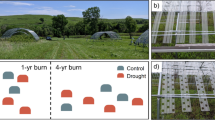Abstract
A glasshouse experiment investigated the effect of bending stress on stem radial and height growth and stem taper ofEucalyptus regnans seedlings. Eighteen-week-old, potted seedlings were bent continuously for 8 weeks with a static bending stress. The bending treatment was then removed and the seedlings grown for another 12 weeks. Other seedlings were stayed vertically throughout the experiment whilst control seedlings were neither bent nor stayed. Seedlings were rotated every 2 days to prevent reaction wood developing asymmetrically in the stems of bent trees. Bent trees had higher radial growth rates, developed more tapered stems and had higher safety factors (the ratio of stem radius to the minimum radius required to prevent the tree toppling over) than unbent seedlings. They produced a band of tension wood in their stems and ceased height growth whilst bent. When bending ceased, they resumed normal radial and height growth. Unbent trees developed more cylindrical stems. There were no differences in growth behaviour between stayed and control trees. Bent and unbent trees all developed a butt swell, the taper of which was not affected by treatment. It was concluded that bending stress has substantial effects on both the size and taper of tree stems. However, the development of butt swell is independent of the bending stress applied. The results were considered in relation to biomechanical theories of tree stem development.
Similar content being viewed by others
References
Bamber RK, Colley RL (1983) A histochemical test for sapwood and heartwood inPinus radiata. Rep J Inst Wood Sci 9: 228
Cannell MGR, Morgan J (1987) Young's modulus of sections of living branches and tree trunks. Tree Physiol 3: 355–364
Dean TJ, Long JN (1986) Validity of constant-stress and elastic-instability principles of stem formation inPinus contorta andTrifolium pratense. Ann Bot 58: 833–840
Downes GM, Moore GA, Turvey ND (1994) Variations in response to induced stem bending in seedlings ofPinus radiata. Trees 8: 151–159
Gray HR (1956) The form and taper of forest tree stems. Institute Paper No 32, Imperial Forestry Institute, Oxford
Holbrook NM, Putz FE (1989) Influence of neighbors on tree form: effects of lateral shade and prevention of sway on the allometry ofLiquidamber styraciflua (Sweet Gum). Am J Bot 76: 1740–1749
Jacobs MR (1954) The effect of wind sway on the form and development ofPinus radiata D.Don. Aust J Bot 2: 35–51
King DA (1981) Tree dimensions: maximising the rate of height growth in dense stands. Oecologia 51: 351–356
King DA (1986) Tree form, height growth, and susceptibility to wind damage inAcer saccharum. Ecology 67: 980–990
King DA, Loucks OL (1978) The theory of tree bole and branch form. Rad Environ Biophys 15: 41–165
Larson PR (1963) Stem form development of forest trees. For Sci Monograph 5
Larson PR (1965) Stem form of young larix as influenced by wind and pruning. For Sci 11: 412–424
Leiser AT, Kemper JD (1973) Analysis of stress distribution in the sapling tree trunk. J Am Soc Hort Sci 98: 164–170
McMahon TA, Kronauer RE (1976) Tree structures: deducing the principle of mechanical design. J Theor Biol 59: 443–466
Milne R, Blackburn P (1989) The elasticity and vertical distribution of stress within stems ofPicea sitchensis. Tree Physiol 5: 195–205
Morgan J, Cannell MGR (1994) Shape of tree stems — a re-examination of the uniform stress hypothesis. Tree Physiol 14: 49–62
Newnham RM (1965) Stem form and the variation of taper with age and thinning regime. Forestry 38: 218–224
Niklas KJ (1994) The allometry of safety-factors for plant height. Am J Bot 81: 345–351
Osawa A (1992) Fine-resolution analysis of stem form and its implication to the mechanism of plant self-thinning. Can J For Res 22: 403–412
Osawa A (1993) Effects of mechanical stresses and photosynthetic production on stem form development ofPopulus maximowiczii. Ann Bot 71: 489–494
Pearson RG, Kloot NH, Boyd JD (1962) Timber engineering design handbook. The Jacaranda Press, Brisbane
Thomson AJ, Barclay HJ (1984) Effects of thinning and urea fertilization on the distribution of area increment along the boles of Douglas-fir at Shawnigan Lake, British Columbia. Can J For Res 14: 879–884
Valinger E (1992) Effects of wind sway on stem form and crown development of Scots pine (Pinus sylvestris L.). Aust For 55: 15–21
West PW, Jackett DR, Sykes SJ (1989) Stresses in, and the shape of, tree stems in forest monoculture. J Theor Biol 140: 327–343
Author information
Authors and Affiliations
Rights and permissions
About this article
Cite this article
Osler, G.H.R., West, P.W. & Downes, G.M. Effects of bending stress on taper and growth of stems of youngEucalyptus regnans trees. Trees 10, 239–246 (1996). https://doi.org/10.1007/BF02185675
Received:
Accepted:
Issue Date:
DOI: https://doi.org/10.1007/BF02185675




